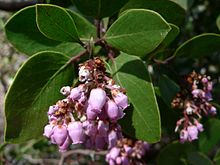| Arctostaphylos | |
|---|---|

| |
| Whiteleaf manzanita (Arctostaphylos viscida) | |
| Scientific classification | |
| Kingdom: | Plantae |
| Clade: | Tracheophytes |
| Clade: | Angiosperms |
| Clade: | Eudicots |
| Clade: | Asterids |
| Order: | Ericales |
| Family: | Ericaceae |
| Subfamily: | Arbutoideae |
| Genus: | Arctostaphylos Adanson |
| Type species | |
| Arctostaphylos uva-ursi | |
| Species | |
|
About 60, see text. | |
Arctostaphylos (/ˌɑːrktoʊˈstæfɪləs, -lɒs/;[1][2] from ἄρκτος árktos "bear" and σταφυλή staphulḗ "bunch of grapes") is a genus of plants comprising the manzanitas (/ˌmænzəˈniːtəz/[3][4]) and bearberries. There are about 60 species of Arctostaphylos, ranging from ground-hugging arctic, coastal, and mountain shrub to small trees up to 6 m (20 ft) tall. Most are evergreen (one species deciduous), with small oval leaves 1–7 cm (0.4–3 in) long, arranged spirally on the stems. The flowers are bell-shaped, white or pale pink, and borne in small clusters of 2–20 together; flowering is in the spring. The fruit are small berries, ripening in the summer or autumn. The berries of some species are edible.
Arctostaphylos species are used as food plants by the larvae of some Lepidoptera species including Coleophora arctostaphyli (which feeds exclusively on A. uva-ursi) and Coleophora glaucella.
- ^ "Arctostaphylos". Merriam-Webster.com Dictionary. Merriam-Webster. Retrieved 2016-01-21.
- ^ Sunset Western Garden Book, 1995:606–607
- ^ "manzanita". Merriam-Webster.com Dictionary. Merriam-Webster. Retrieved 2016-01-21.
- ^ "manzanita". Lexico UK English Dictionary. Oxford University Press. Archived from the original on 2020-03-22.